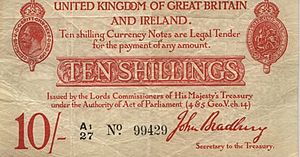Bank of England 10 shilling note facts for kids
| (United Kingdom) | |
|---|---|
| Value | 10/– sterling |
| Width | 140 mm |
| Height | 67 mm |
| Paper type | Cotton |
| Years of printing | 1928–1969 |
| Obverse | |
 |
|
| Design | Queen Elizabeth II |
| Design date | 12 October 1961 |
| Reverse | |
 |
|
| Design | Bank of England logo |
| Design date | 12 October 1961 |
The Bank of England 10 shilling note, often called the 10 bob note, was a special paper money in the United Kingdom. It was worth ten shillings, which was half of one pound. This note was the smallest paper money ever made by the Bank of England.
The Bank of England first printed the 10 shilling note in 1928. They kept printing it until 1969. The note stopped being used as official money in 1970. It was replaced by the fifty pence coin. This change happened because prices were going up (called inflation) and because the UK was changing to a new money system (called decimalization).
History of the 10 Shilling Note
In the 1700s and 1800s, banknotes were often written by hand. You could swap them for gold at the bank. But during the First World War, the British Government wanted to keep its gold. So, banks were told to stop giving gold for banknotes.
The HM Treasury introduced £1 and 10 shilling notes instead of gold coins. People called these notes "Bradburys". This was because Sir John Bradbury's signature was clearly visible on them.
In 1925, Britain started using the gold standard again. This meant notes could be exchanged for gold. But only if you had a lot of notes, enough for 400 ounces of gold or more. In 1928, the Bank of England took over printing the 10 shilling notes. By 1931, Britain stopped using the gold standard completely. So, banknotes could no longer be swapped for gold.
The first Bank of England 10 shilling notes were red and had printing on both sides. On the front, it said, "I promise to pay the bearer on demand the sum of ten shillings." This promise is still on Bank of England notes today.
During the Second World War, in 1940, the notes changed colour. They became mauve and grey. This was to make it harder for people to copy them. A thin metal thread was also added inside the paper. This was a new security feature. After the war, the notes went back to their original red colour. Notes printed from October 1948 onwards kept the metal thread.
In 1961, a new design for the 10 shilling note came out. The older notes stopped being official money in 1962. These new notes were a bit longer and narrower. They were the first 10 shilling notes to show a picture of Queen Elizabeth II on the front. The back of the note had the logo of the Bank of England.
In the late 1960s, it was decided that future banknotes should show a famous British person on the back. For example, the £20 note, made in 1970, showed William Shakespeare. A design for a 10 shilling note with Walter Raleigh on the back was approved in 1964. However, this note was never actually made.
The 10 shilling note was eventually replaced by a coin. This was because of rising prices. The 10 shilling note stopped being official money on November 22, 1970.
See also


